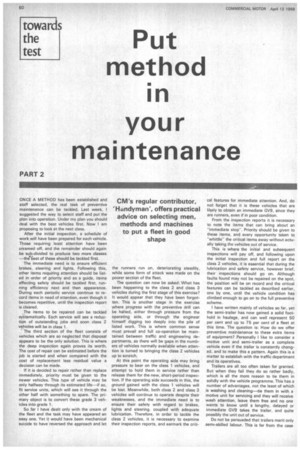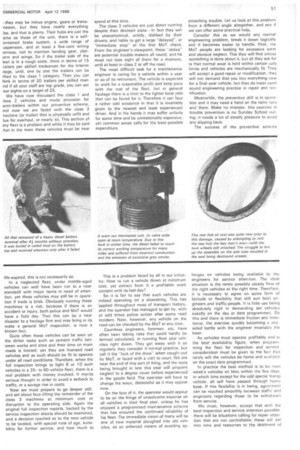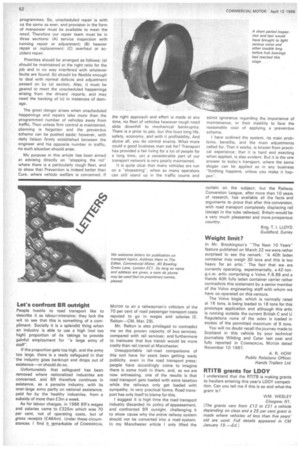Put method in your maintenance
Page 52

Page 53

Page 54

If you've noticed an error in this article please click here to report it so we can fix it.
CIVI's regular contributor, 'Handyman', offers practical advice on selecting men, methods and machines to put a fleet in good shape PART 2
ONCE A METHOD has been established and staff selected, the real task of preventive maintenance can be tackled. Last week, I suggested the way to select staff and put the plan into operation. Under my plan you should deal with the best vehicles first. Now I am proposing to look at the next class.
After the initial inspection, a schedule of work will have been prepared for each vehicle. Those requiring least attention have been creamed off, and the remainder should again be •sub-divided to produce two more classes —theabest of these should be tackled first.
The immediate need is to ensure efficient brakes, steering and lights. Following this, other items requiring attention should be listed in order of priority and as a guide, items affecting safety should be tackled first, running efficiency next and then appearance. During each periodic service continue to record items in need of attention, even though it becomes repetitive, until the inspection report is cleared.
The items to be repaired can be tackled systematically. Each service will see a reduction of outstanding jobs and soon class 2 vehicles will be in class 1.
The third section of the fleet consists of vehicles which are so neglected that disposal appears to be the only solution. This is where the deep inspection again proves its worth. The cost of repair can be estimated before the job is started and when compared with the cost of replacement less residual value a decision can be made.
If it is decided to repair rather than replace immediately, priority must be given to the newer vehicles. This type of vehicle may be only halfway through its estimated life—if so, fit service units, which will see it through the other half with something to spare. The primary object is to convert these grade 3 vehicles into grade 1.
So far I have dealt only with the cream of the fleet and the task may have appeared an easy one. Yet it would have been mechanical suicide to have reversed the approach and let the runners run on, deteriorating steadily, while some form of attack was made on the poorer section of the fleet.
The question can now be asked: What has been happening to the class 2 and class 3 vehicles during the first stage of this exercise? It would appear that they have been forgotten. This is another stage in the exercise where progress with the preventive drill can be halted, either through pressure from the operating side, or through the engineer himself digging too deeply into the pile of listed work. This is where common sense must prevail and full co-operation be maintained between traffic and engineering departments, as there will be gaps in the numbers of vehicles normally available when attention is turned to bringing the class 2 vehicles up to scratch.
At this point the operating side may bring pressure to bear on the class 1 vehicles, and attempt to hold them in service rather than release them for the new, short-period inspection. If the operating side succeeds in this, the ground gained with the class 1 vehicles will be lost. Meanwhile, both class 2 and class 3 vehicles will continue to operate despite their weaknesses, and the immediate need is to ensure their safety with regard to brakes, fights and steering, coupled with adequate lubrication. Therefore, in order to tackle the class 2 vehicles, it is necessary to examine their inspection reports, and earmark the criti
cal features for immediate attention. And, do not forget that it is these vehicles that are likely to obtain an immediate GV9, since they are runners, even if in poor condition.
From the inspection reports it is necessary to note the items that can bring about an "immediate stop". Priority should be given to these items, and every opportunity taken to "whittle". the critical items away without actually taking the vehicles out of service.
This is where the initial and subsequent inspections will pay off, and following upon the initial inspection and full report on the class 2 vehicles, it is essential that during the lubrication and safety service, however brief, their inspections should go on. Although faults found may not be repaired on the spot, the position will be on record and the critical features can be tackled as described earlier, one by one, until the vehicle condition has climbed enough to go on to the full preventive scheme.
I have written mainly of vehicles so far, yet the semi-trailer has now gained a solid foothold in haulage, and can well represent 50 per cent and up to 75 per cent of a fleet at this time. The question is: How do we offer preventive maintenance to these extra items of equipment? Personally I like to consider a motive unit and semi-trailer as a complete vehicle even if the trailer is constantly changed, and to make this a pattern. Again this is a matter to establish with the traffic department and its operatives.
Trailers are all too often taken for granted. But when they fail they do so rather badly, which is all the more reason to tie them in solidly with the vehicle programme. This has a number of advantages, not the least of which is washing and cleaning tie them in with a motive unit for servicing and they will receive wash attention, leave them free and no one wants to know until a lengthy, delayed or immediate GV9 takes the trailer, and quite possibly the unit out of service.
Do not be persuaded that trailers merit only semi-skilled labour. This is far from the case —they may be minus engine, gears or translission, but they have nearly everything Ise, and that is plenty. Their hubs are just the ame as those of the unit, there is a selfontained brake system, a wide range of uspension, and at least a five-core wiring iarness, not to mention landing gear, platorm and wings. So if the trailer side of the leet is in a rough state, think in terms of 15 railers per skilled tradesman for the interim liege, until, one by one the trailers can be ifted to the class 1 category. Then you can hink in terms of 20 trailers per skilled man ind if all your staff are top grade, you can set 'our sights on a target of 25.
We have now discussed the class 1 and :lass 2 vehicles and made provision for :emi-trailers within our preventive scheme, ind now we are faced with the class 3 nachine (or trailer) that is physically unfit and lue for overhaul, or nearly so. This section of my fleet is a problem and while it may be said :hat in the main these vehicles must be near life-expired, this is not necessarily so.
In a neglected fleet, under middle-aged vehicles can well have been run to a near standstill with major items in need of attention, yet these vehicles may still be in operation if trade is brisk. Obviously running these machines is a risk, because if there is an accident or injury, both police and MoT would' have a field day. That this can be a near disaster to a haulage firm and may bring in its wake a general MoT inspection, is now a known fact.
Quite often these vehicles can' be seen on the dirtier tasks such as cement traffic between works and sites and their time on main roads is limited, yet they are licensed road vehicles and as such should be fit to operate under all road conditions. Therefore, when the full inspection brings to light 8 or 10 such vehicles in a 35to 60-vehicle fleet, there is a real problem with money involved. It merits serious thought in order to avoid a setback to traffic, or a savage rise in costs.
Now we must prepare to go deeper still, and set about face-lifting the remainder of the class 3 machines at minimum cost or disruption to the operating side. Again the original full inspection reports, backed by the service inspection sheets should be examined, and a decision reached as to the next vehicle to be tackled, with special note of age, suitability for further service, and how much to spend at this time.
The class 3 vehicles are just about running despite their decrepit state—in fact they will be uneconomical, untidy, disliked by their drivers, and liable to get a large "delayed", or "immediate stop" at the first MoT check. From the engineer's viewpoint, these "oldies" are potential trouble-makers all round, and he .must not lose sight of them for a moment, until at least in class 2 or off the road.
The most difficult task for a maintenance engineer is caring for ' a vehicle within a year or so of its retirement. The vehicle is expected to work for a reasonable profit and keep pace with the rest of the fleet, but in general haulage there is a limit to the lighter local jobs that can be found for it. Therefore it can face a rather odd existence in that it is invariably given to the newest and least experienced driver. And in his hands it may suffer unfairly for some time and be unreasonably expensive, yet common sense calls for the least possible expenditure.
This is a problem faced by all in our industry: How to run a vehicle down at minimum cost, yet extract from it a profitable work content until its last day?
So it is fair to say that such vehicles are indeed operating on a shoestring. This has 'applied throughout most of transport history, and the operator has managed to get by, with at odd times police action after some road incident. Now, however, any vehicle on the road can be checked by the MoT at any time.
Countless engineers, foremen, etc, have often been taking risks that could hardly be, termed calculated, in running final year vehicles right down. They get away with it so regularly they consider it normal practice, but call it the "luck of the draw" when caught out by MoT, or faced with a visit to court. We are near the end of this sort of thing, and the tests being brought in late this year will pinpoint neglect to a degree never before experienced in the goods field. The operator will have to change his ways, distasteful as it may appear now.
On the face of it, the operator would appear to be on the fringe of unwelcome expense on all vehicles in their final year, unless he has enjoyed a programmed maintenance scheme that has ensured the continued reliability of his fleet. The immediate vision of many will be one of new material ploughed into old vehicles, as an enforced means of avoiding ap
proaching trouble. Let us look at this problem from a different angle altogether, and see if we can offer some practical help.
Consider this as we would any normal engineering problem, break it down logically and it becomes easier to handle. First, the MoT people are looking for excessive wear and obvious neglect. This they will find unless something is done about it, but all they ask for is that normal wear is held within certain safe limits and vehicles are mechanically fit. They will accept a good repair or modification, they will not demand that you buy everything new for a final-year vehicle, but they do insist upon sound engineering practice in repair and rectification.
Meanwhile, the preventive drill is in operation and it may need a hand on the helm here and there. Make no mistake, this exercise in trouble prevention is no Sunday School outing; it needs a lot of steady pressure to avoid any slipping back.
The success of the preventive scheme hinges on vehicles being available to the engineers for service attention. The ideal situation is the rarely possible steady flow of the right vehicles at the right time. Therefore, it is necessary to agree on some form of latitude or flexibility that will suit both engineers and traffic people. It is little use being absolutely rigid in demanding set vehicles exactly on the day or date programmed. Do this and there is immediate friction and resistance, the exercise quickly becoming a one sided battle with the engineer invariably the loser.
As vehicles must operate profitably and at the best availability figure, when programming the fleet for inspection and service, consideration must be given to the fact that rarely will the vehicles be home and available on the exact date programmed.
In practice the best method is to list next week's vehicles en bloc within the five days, in which time except for the odd special tramp vehicle, all will have passed through home base. If this flexibility is in being, agreement can be reached smoothly between traffic and engineers regarding those to be withdrawn from service.
We must, however, accept that with the best inspection and service attention possible, there will be situations calling for repair atten tion that are not controllable; these will eat into time and resources to the detriment of programmes. So, unscheduled repair is with us the same as ever, and provision in the form of manpower must be available to meet the need. Therefore our repair team must be in three sections: (A) service inspection with running repair or adjustment; (B) heavier repair or replacement; (C) overhaul or accident repair.
Priorities should be arranged as follows: (a) should be maintained at the right ratio for the job and in no way interfered with whatever faults are found; (b) should be flexible enough to deal with normal defects and adjustment passed on by (a) section. Also, it must be geared to meet the unscheduled happenings arising from the drivers' reports, and may need the backing of (c) in instances of damage.
The great danger arises when unscheduled happenings and repairs take more than the programmed number of vehicles away from traffic. Then unless firm control is maintained, planning is forgotten and the preventive scheme can be pushed aside: however, with daily liaison firmly established between the engineer and his opposite number in traffic, no such situation should arise.
My purpose in this article has been aimed at advising directly on "stopping the rot" where there is a particularly rough fleet, and to show that Prevention is indeed better than Cure, where vehicle welfare is concerned. If the right approach and effort is made at any time, no fleet of vehicles however rough need slide downhill to mechanical bankruptcy. There is a price to pay, but this buys long life, safety, economy, and with it profitability. And above all, you do control events. What more could a good business man ask for? Transport has provided a fair living for a lot of people for a long time, yet a considerable part of our transport network is very poorly maintained.
It is quite clear that many vehicles are run on a "shoestring", when so many operators can still stand up in the traffic courts and admit ignorance regarding the importance of maintenance, or their inability to face the reasonable cost of applying a preventive scheme.
I have outlined the system, its main problems, benefits, and the main adjustments called for. That it works, is known from practical experience; that it is hard and exacting when applied, is also evident. But it is the one answer to today's transport, where the same slogan can be applied as in any business "Nothing happens, unless you make it happen".




































































































